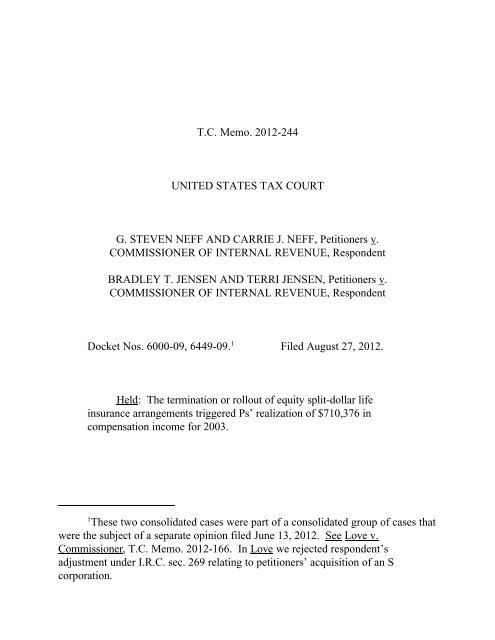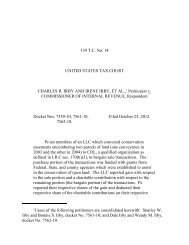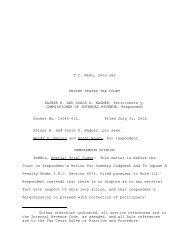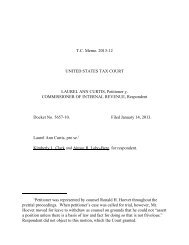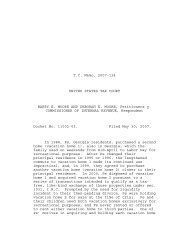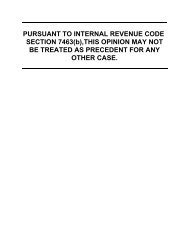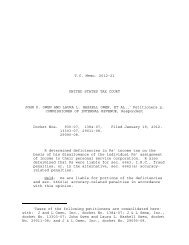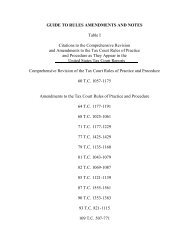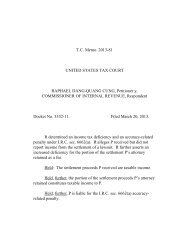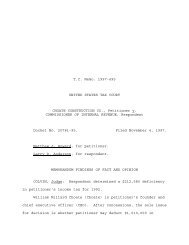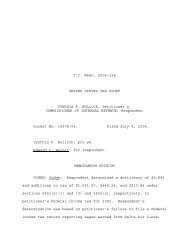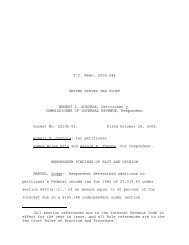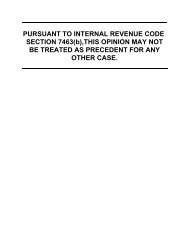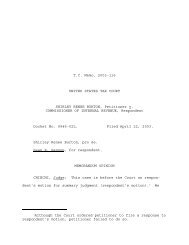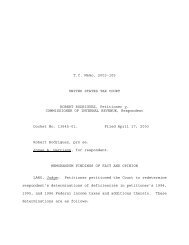TC Memo. 2012-244 - U.S. Tax Court
TC Memo. 2012-244 - U.S. Tax Court
TC Memo. 2012-244 - U.S. Tax Court
You also want an ePaper? Increase the reach of your titles
YUMPU automatically turns print PDFs into web optimized ePapers that Google loves.
T.C. <strong>Memo</strong>. <strong>2012</strong>-<strong>244</strong><br />
UNITED STATES TAX COURT<br />
G. STEVEN NEFF AND CARRIE J. NEFF, Petitioners v.<br />
COMMISSIONER OF INTERNAL REVENUE, Respondent<br />
BRADLEY T. JENSEN AND TERRI JENSEN, Petitioners v.<br />
COMMISSIONER OF INTERNAL REVENUE, Respondent<br />
Docket Nos. 6000-09, 6449-09. 1 Filed August 27, <strong>2012</strong>.<br />
Held: The termination or rollout of equity split-dollar life<br />
insurance arrangements triggered Ps’ realization of $710,376 in<br />
compensation income for 2003.<br />
1 These two consolidated cases were part of a consolidated group of cases that<br />
were the subject of a separate opinion filed June 13, <strong>2012</strong>. See Love v.<br />
Commissioner, T.C. <strong>Memo</strong>. <strong>2012</strong>-166. In Love we rejected respondent’s<br />
adjustment under I.R.C. sec. 269 relating to petitioners’ acquisition of an S<br />
corporation.
- 2 -<br />
[*2] W. Waldan Lloyd, David R. York, and Daniel S. Daines, for petitioners.<br />
Charles B. Burnett and Milan H. Kim, for respondent.<br />
MEMORANDUM FINDINGS OF FACT AND OPINION<br />
SWIFT, Judge: In these consolidated cases, respondent determined<br />
deficiencies of $120,097 and $135,994 in the Neffs’ and Jensens’ respective Federal<br />
income tax for 2003 2 and penalties under section 6662(a). 3<br />
The primary issue for decision is whether equity split-dollar life insurance<br />
arrangements were terminated and whether, when, and to what extent petitioners<br />
G. Steven Neff and Bradley T. Jensen are taxable thereon.<br />
FINDINGS OF FACT<br />
Some of the facts have been stipulated and are so found.<br />
At the time of filing their petitions, petitioners resided in Utah.<br />
2 Respondent has stipulated reductions in his deficiency determinations due to<br />
miscalculations made in his notices of deficiency. Above, we reflect respondent’s<br />
deficiencies as recalculated by respondent.<br />
3 Unless otherwise indicated, all section references are to the Internal Revenue<br />
Code (Code) in effect for the year in issue, and all Rule references are to the <strong>Tax</strong><br />
<strong>Court</strong> Rules of Practice and Procedure.
- 3 -<br />
[*3] Hereinafter, references to petitioners are generally to G. Steven Neff and<br />
Bradley T. Jensen.<br />
Since 1979 petitioners each have owned a 50% interest in a Utah regular<br />
corporation named Neff & Jensen Construction, Inc. (N & J Construction).<br />
N & J Construction has engaged in the business of commercial concrete work.<br />
Also, for many years petitioners together and separately have owned and operated a<br />
number of other related companies and partnerships.<br />
On February 20, 2002, petitioners formed Neff & Jensen Leasing, Inc., as a<br />
Utah subchapter S corporation (N & J Management) to provide management,<br />
personnel, and accounting services for a number of related companies and<br />
businesses, including N & J Construction. All of the stock in N & J Management<br />
was owned by an employee stock ownership plan (ESOP), also formed in February<br />
2002.<br />
Petitioners were the officers of N & J Management. Mr. Jensen was<br />
president; Mr. Neff was vice president, treasurer, secretary, and director.<br />
Petitioners were the only trustees of the ESOP.<br />
After formation of N & J Management the employees of N & J Construction<br />
and the related companies continued doing the same work but they became<br />
employees of N & J Management and participants in the ESOP.
- 4 -<br />
[*4] During 2002 and 2003 N & J Management made premium payments due on<br />
six life insurance policies issued by the Lincoln National Life Insurance Co.<br />
covering the lives of petitioners. The life insurance policies were entered into for<br />
business and estate planning purposes--namely, to fund cross-purchase buy-sell<br />
stock agreements entered into between petitioners and to provide estate liquidity<br />
upon the deaths of petitioners.<br />
N & J Management’s agreement to pay premiums due on the six life<br />
insurance policies on petitioners’ lives was based on and related to the employment<br />
relationship they had with and the services they provided for N & J Management.<br />
Technically, the life insurance policies were owned by petitioners and by<br />
GSN Investment, Ltd. (GSN) and TerSen, Ltd. (TerSen), family limited<br />
partnerships owned by petitioners and immediate family members. Mr. Steven<br />
Neff owned one of the life insurance policies. Mr. Bradley Jensen owned one of<br />
the life insurance policies. GSN owned two of the life insurance policies, and<br />
TerSen owned the other two life insurance policies. Hereinafter, only limited
- 5 -<br />
[*5] references are made to GSN and TerSen, and references to petitioners<br />
occasionally and where appropriate include GSN and TerSen. 4<br />
The obligation of N & J Management to pay premiums due on the six life<br />
insurance policies was part of four equity split-dollar life insurance arrangements<br />
(hereinafter sometimes referred to as SDLIA or SDLIAs) that were memorialized in<br />
four essentially identical written SDLIA agreements that were entered into on<br />
March 6, 2002, between petitioners and N & J Management.<br />
As stated, under the SDLIA agreements formal ownership rights in the six<br />
life insurance policies were held by petitioners, not N & J Management. As<br />
employer, however, N & J Management agreed and was obligated to pay the<br />
premiums due on the life insurance policies, and petitioners agreed that upon<br />
either termination of the life insurance policies (such as upon the deaths of<br />
petitioners) or upon termination of the SDLIAs for some other reason (such as<br />
upon a third-party sale of N & J Management and regardless of whether the life<br />
insurance policies were canceled), N & J Management would have the right to be<br />
reimbursed an amount equal to the lesser of the total premiums it had paid on the<br />
4 Petitioners Steven and Carrie Neff owned a 2% interest in GSN, and the<br />
remaining 98% interest in GSN was owned beneficially by their children.<br />
Petitioners Bradley and Terri Jensen owned a 2% interest in TerSen, and the<br />
remaining 98% in TerSen was owned beneficially by their children.
- 6 -<br />
[*6] six life insurance policies or the total cash surrender value of the policies.<br />
Paragraph (2) of the SDLIA agreements provided in part as follows:<br />
(b) [N & J Management] shall have no incidents of ownership over the<br />
Policies and shall only have the right to collect * * * its interest in the<br />
proceeds of the Policies * * * upon the death of * * * [petitioners],<br />
termination of this Agreement for any reason whatsoever, or upon the<br />
lapse, cancellation, or surrender of the Policies. [Emphasis added.]<br />
Paragraph (3) of the SDLIA agreements acknowledged that N & J<br />
Management’s life insurance policy premium payments created “indebtedness” from<br />
petitioners to N & J Management.<br />
Paragraph (4) described N & J Management’s premium payments as<br />
“advances” as follows:<br />
(4) Policy Interest<br />
(a) [N & J Management Company’s] Interest<br />
[N & J Management] has the right to receive back an<br />
amount equal to the premium advances it has made on<br />
the Policies. [Emphasis added.]<br />
If petitioners died when the SDLIAs and life insurance policies were still in<br />
effect, paragraph (6) of the SDLIA agreements provided the obvious--namely, that<br />
the life insurance policy proceeds would be paid “after the death of * * *<br />
[petitioners].”
- 7 -<br />
[*7] Paragraph (7)(a) added that if the life insurance policies were terminated or<br />
canceled before the deaths of petitioners, N & J Management was to receive<br />
reimbursement of the policy premiums it had paid out of the cash value of the<br />
policies (death policy proceeds not yet being available).<br />
Apart from the life insurance policies covering the lives of petitioners and<br />
regardless of whether the policies remained in effect, the SDLIA agreements<br />
provided that the SDLIAs themselves could be terminated by agreement of<br />
petitioners and N & J Management. Paragraph (8) provided as follows:<br />
(8) Termination of Agreement<br />
This Agreement shall terminate for any of the following reasons:<br />
(a) Performance of its terms following the death of the Insured;<br />
(b) Written agreement of all of the parties hereto specifically<br />
terminating this Agreement.<br />
The SDLIA agreements did not state that the parties to the agreement (namely,<br />
petitioners and N & J Management) could not terminate the agreement by mutual<br />
oral agreement.<br />
Paragraph (9) of the SDLIA agreements reiterated that in the event of a<br />
termination of the SDLIAs other than by the deaths of petitioners reimbursement
- 8 -<br />
[*8] to N & J Management of the policy premiums it had paid would be made out of<br />
the cash values of the insurance policies.<br />
Paragraph (10) of the SDLIA agreements expressly provided that<br />
N & J Management’s interest in the policies could be either “satisfied” (by full<br />
reimbursement of premiums paid ) or “released” by N & J Management.<br />
Under paragraph 3(b) of written collateral assignment agreements relating to<br />
the SDLIA agreements that petitioners executed, death benefits from the six life<br />
insurance policies and the cash surrender value thereof were pledged in favor of<br />
N & J Management to provide security for N & J Management’s premium<br />
reimbursement rights and petitioners’ “liabilities * * * to [N & J Management] for<br />
premium advances” N & J Management had made.<br />
Paragraph 5(c) of the collateral assignment agreements stated that N & J<br />
Management had the right to reimbursement of the premiums it paid “in the event of<br />
termination” of the SDLIAs.<br />
Nothing in the SDLIA agreements and the collateral assignment agreements<br />
suggests that--upon termination of the SDLIAs for reasons other than the deaths of<br />
petitioners--reimbursement to N & J Management of the premiums it paid on the<br />
policies would be put off until the deaths of petitioners and receipt of the life<br />
insurance proceeds.
- 9 -<br />
[*9] As beneficiaries, petitioners (and their heirs) retained the right to access cash<br />
values and to receive proceeds of the life insurance policies but only to the extent<br />
they exceeded premium reimbursements owed and paid to N & J Management.<br />
The cash surrender value of the six life insurance policies increased with the<br />
passage of time and as the premiums paid were invested by the insurance company.<br />
Under the life insurance policies and the SDLIAs from March 2002 through<br />
the end of December 2003 a total of $842,345 in premiums on the six policies was<br />
paid by N & J Management to the Lincoln Life Insurance Co. As of December 31,<br />
2003, the total cash surrender value of the policies was $877,432.<br />
Because of a new regulatory scheme the Commissioner adopted in 2002 for<br />
split-dollar life insurance arrangements (explained more fully below), in late 2003<br />
and on advice of counsel petitioners decided to terminate the SDLIAs. In December<br />
2003 by agreement of petitioners and N & J Management the four SDLIA<br />
arrangements between petitioners and N & J Management relating to the six life<br />
insurance policies were terminated. 5<br />
5 The precise date in December 2003 on which the SDLIA arrangements were<br />
terminated is not established in the record.
- 10 -<br />
[*10] After December 2003 N & J Management made no further payments on the<br />
six life insurance policies. N & J Management released its interest in the policies<br />
(namely, its premium reimbursement rights) with respect to which N & J<br />
Management in less than two years had paid $842,345 in premiums.<br />
Upon termination of the SDLIA arrangements in December 2003 N & J<br />
Management had fixed rights to receive reimbursement of $842,345 (the lesser of<br />
the total premiums paid or the total cash surrender value of the policies). This<br />
$842,345 represented the total premium “advances” N & J Management had made<br />
on the life insurance policies and petitioners’ total indebtedness to N & J<br />
Management with regard thereto.<br />
At the request of petitioners’ counsel, individuals at petitioners’ accounting<br />
firm calculated what they regarded as the “December 2003” fair market value of<br />
N & J Management’s rights to be reimbursed the $842,345 premiums paid.<br />
However, apparently on advice of petitioners’ counsel, the individuals at<br />
petitioners’ accounting firm treated N & J Management’s reimbursement rights as<br />
the right to be reimbursed the $842,345 only upon the deaths of petitioners. The<br />
accounting firm applied a present value discount for the $842,345--using an
- 11 -<br />
[*11] assumed life expectancy for each petitioner of 85 and an interest rate of 6%. 6<br />
Petitioners’ advisers calculated the December 2003 present value of N & J<br />
Management’s $842,345 reimbursement rights at $131,969.<br />
In December 2003 petitioners and N & J Management agreed that N & J<br />
Management would be reimbursed only the $131,969, as calculated above, and<br />
N & J Management agreed to release its interests in the present cash surrender<br />
value of the policies, future death benefits from the policies, and petitioners from<br />
any reimbursement obligation to N & J Management with regard to the $710,376<br />
balance of the premiums N & J Management paid on the life insurance policies. 7<br />
On the basis of the above agreement and calculation, on January 11 and 12,<br />
2004, petitioners wrote personal checks totaling $131,969 in favor of N & J<br />
Management. The checks were deposited into N & J Management’s bank account<br />
on January 13, 2004.<br />
Funding for the $131,969 petitioners paid to N & J Management came from<br />
their draw on the accumulated cash value of the six underlying life insurance<br />
policies.<br />
$710,376.<br />
6 On December 31, 2003, each petitioner was 51.<br />
7 Total premiums paid of $842,345 less $131,969 reimbursed equals
- 12 -<br />
[*12] As between petitioners and N & J Management, as of the end of December<br />
2003 N & J Management was treated as having no obligation to make additional<br />
premium payments on the six life insurance policies and the SDLIA arrangements<br />
were treated as having been released, ended, or terminated. Upon the above<br />
termination of the SDLIA arrangements, petitioners had sole rights to the remaining<br />
$745,463 balance in the cash surrender value of the life insurance policies. 8<br />
Apparently, no contemporaneous documentation exists (or was offered into<br />
evidence) relating to the December 2003 agreement between petitioners and<br />
N & J Management that ended or terminated the SDLIA arrangements. No written<br />
termination letter or agreement between petitioners and N & J Management with<br />
regard to the SDLIAs was offered into evidence. No written contract of any kind<br />
was offered into evidence relating to the above December 2003 agreement to end<br />
the SDLIAs. Further, no contemporaneous documentation refers to a sale by<br />
N & J Management to petitioners of “contract rights”.<br />
$745,463.<br />
8 Total cash surrender value of $877,432 less $131,969 received equals
- 13 -<br />
[*13] After December 2003 the six life insurance policies insuring petitioners’ lives<br />
apparently remained in effect, and petitioners individually apparently made premium<br />
payments due thereon.<br />
The evidence in these cases does not indicate that (during the short life of the<br />
SDLIA--March 2002 through December 2003) petitioners for 2002 and 2003, as<br />
well as for 2004, included in their taxable income any amount relating to the life<br />
insurance premiums N & J Management paid, the value of the policies, the<br />
dividends, the paid-up additions, or any other amount or value. 9<br />
Further, on the basis of their advisers’ $131,969 present value calculation of<br />
N & J Management’s premium reimbursement rights under the SDLIAs, petitioners<br />
did not report on their respective Federal income tax returns for 2003 or 2004 any<br />
income regarding the $710,376 difference between the $131,969 petitioners<br />
reimbursed N & J Management and the $842,345 N & J Management paid in<br />
premiums on the policies.<br />
On audit respondent determined that in December 2003 on termination of<br />
the SDLIA arrangements petitioners realized taxable compensation income of<br />
9 If petitioners for 2002 or 2003 had reported any taxable income relating to<br />
the economic benefits of the SDLIAs and the insurance policies, they could have<br />
asserted and would have been entitled to a reduction in respondent’s adjustments<br />
herein for their resulting tax bases therein.
- 14 -<br />
[*14] $710,376, the difference between what they reimbursed N & J Management<br />
and what N & J Management paid in premiums on the policies.<br />
In spite of the four life insurance policies owned by GSN and TerSen and the<br />
SDLIAs relating thereto, respondent did not make any reduction in the income<br />
charged to petitioners, did not charge any income to GSN or TerSen, and did not<br />
issue notices of deficiency to GSN or TerSen. The $710,376 in compensation<br />
income respondent determined was charged to and allocated solely to and between<br />
Mr. Steven Neff and Mr. Bradley Jensen.<br />
In letters to respondent’s revenue agent of July 27 and November 15, 2007, in<br />
their petition, and in their opening statement at trial, petitioners’ counsel described<br />
the transaction before us as involving a “termination” of the SDLIAs.<br />
Through audit and up until the time of trial petitioners and their attorneys,<br />
accountants, and experts, as well as respondent, treated the transaction before us as<br />
occurring in December 2003.<br />
On February 17, 2011, petitioners’ accounting firm provided a written<br />
calculation or report of N & J Management’s premium reimbursement rights. Again<br />
apparently on advice of counsel, this written calculation treated<br />
N & J Management’s reimbursement rights as not effective until the death of each<br />
petitioner some 30 years after December 2003.
- 15 -<br />
[*15] The above calculation that the accounting firm prepared for petitioners in<br />
February 2011 described what happened to the SDLIAs and the timing thereof, as<br />
follows:<br />
In December 2003, as a result of split-dollar tax regulations and the<br />
proposed section 409(p) regulations * * * the plan was ended.<br />
[Emphasis added.]<br />
Not until trial herein (which occurred on September 6, 2011) did petitioners’<br />
counsel raise the argument and take the position that because petitioners’ premium<br />
reimbursement checks to N & J Management were not executed by them and not<br />
cashed by N & J Management until January 2004, if any compensation income is to<br />
be charged to them it should be charged for 2004, not 2003, and that any effort by<br />
respondent now to move the income to 2004 would be untimely and should not be<br />
allowed.<br />
Petitioners’ counsel states that not until just before trial did he review the<br />
bank records and realize that petitioners’ reimbursement payments occurred in<br />
2004, as follows:<br />
The exact date of the Transactions was not known to petitioners’<br />
counsel until just prior to the trial date on September 6, 2011, when<br />
petitioners’ counsel was able to obtain and review from the bank<br />
copies of the cancelled checks that * * * [petitioners] * * * used to pay<br />
the management Company.
- 16 -<br />
[*16] No explanation is provided as to why petitioners’ counsel was not able to<br />
obtain and review the 2004 bank records and canceled checks before September<br />
2011.<br />
OPINION<br />
In the life insurance industry, the term “rollout” is used to describe<br />
termination of an SDLIA other than by death of the insured employee that results in<br />
cancellation of the employer’s premium payment obligation relating to the life<br />
insurance policy and that leaves the insured employee as the sole owner and interest<br />
holder in the policy.<br />
When a rollout of an SDLIA occurs, the employer generally is entitled to be<br />
reimbursed by the insured employee or owner of the insurance policy the lesser of<br />
the total premiums the employer paid on the related life insurance policy or the cash<br />
surrender value of the policy at the time of the rollout.<br />
Exit strategies from SDLIAs have been described as follows:<br />
Split-dollar exit strategies traditionally are known as “roll-out” spiltdollar<br />
arrangements--perhaps better described as an unwinding of the<br />
split-dollar arrangement during the insured’s lifetime, or a release of<br />
the employer’s interest in the policy under the arrangement during the<br />
insured’s lifetime. These strategies contemplate termination of the<br />
arrangement by a transfer of the policy or a release of the employer’s<br />
interest in the policy to the insured or to a third-party owner sometime<br />
during the insured’s lifetime, after repayment to the corporation of its<br />
“interest” in the policy. Normally, repayment is accomplished by
- 17 -<br />
[*17] having the policy owner withdraw from or borrow against the<br />
policy to generate the cash needed to repay the employer, which<br />
cannibalizes the policy. * * * Withdrawals for collateral assignment<br />
arrangements are tax-free only up to the owner’s basis--i.e., the<br />
contributed or taxed economic benefit amounts * * * [Lawrence Brody,<br />
et al., Insurance-Related Compensation, 386-4th <strong>Tax</strong> Mgmt. (BNA), at<br />
A-118-A-119 (2009).]<br />
Over the years the Commissioner provided little and somewhat confusing<br />
administrative guidance on the income tax treatment to corporate executives of the<br />
economic benefits associated with SDLIA arrangements. See, e.g., Rev. Rul. 55-<br />
713, 1955-2 C.B. 23; Rev. Rul. 64-328, 1964-2 C.B. 11; Rev. Rul. 66-110, 1966-1<br />
C.B. 12; IRS Notice 2001-10, 2001-1 C.B. 459.<br />
In 2002 and 2003, as SDLIAs became popular, the Commissioner issued a<br />
number of additional rulings, notices, and proposed regulations. See Rev. Rul.<br />
2003-105, 2003-2 C.B. 696; IRS Notice 2002-8, 2002-1 C.B. 398; secs. 1.61-22,<br />
1.7872-15, Proposed Income <strong>Tax</strong> Regs., 67 Fed. Reg. 45414 (July 9, 2002),<br />
published as final Income <strong>Tax</strong> Regs., 68 Fed. Reg. 54344 (Sept. 17, 2003).<br />
On September 17, 2003, the Commissioner issued final regulations clarifying<br />
and changing how taxpayers prospectively should account annually for their<br />
incremental gain in equity SDLIAs. See sec. 1.61-22(d)(2), Income <strong>Tax</strong> Regs.<br />
These final regulations, however, were made inapplicable to SDLIAs
- 18 -<br />
[*18] entered into on or before September 17, 2003, and not materially modified<br />
thereafter. See sec. 1.61-22(j), Income <strong>Tax</strong> Regs.<br />
Because the SDLIAs in these cases were entered into on March 6, 2002, and<br />
were not substantially modified before termination, the Commissioner’s final<br />
regulations do not apply. 10 Instead, Rev. Ruls. 64-328 and 66-110, supra, and IRS<br />
Notice 2002-8, supra, apply to the SDLIAs involved in these cases (i.e., those<br />
entered into after January 27, 2002, but on or before September 17, 2003).<br />
Thereunder, for each year an SDLIA was in effect, an employee was required to<br />
include in taxable income the total value or cost of the economic benefit received<br />
each year by the employee, less any amount contributed by the employee. As<br />
indicated, petitioners did not include in their taxable income any amount with regard<br />
to the economic benefits they received in 2002, 2003, or 2004 with regard to the<br />
SDLIAs.<br />
Petitioners now contend that no termination or rollout of the SDLIAs<br />
occurred, that they purchased from N & J Management for a discounted present<br />
value only “contract rights,” that they paid fair value therefor, that the SDLIAs<br />
10 Respondent has chosen not to treat the December 2003 transaction involved<br />
herein as a modification of the SDLIAs.
- 19 -<br />
[*19] remain in effect, that they were not released from any indebtedness, and that<br />
they realized no compensation income relating thereto.<br />
To the contrary, we believe it obvious that a cancellation, an unwinding, a<br />
release, or a rollout of N & J Management’s interests in the SDLIAs occurred. The<br />
formal SDLIA agreements may not have been technically or formally terminated by<br />
a written document, but as of the end of December 2003, the SDLIA arrangements<br />
were unwound, and N & J Management was released from its obligation as<br />
employer to provide further funding on the life insurance policies. Petitioners have<br />
stipulated that after and as a result of the transaction at issue in these cases, N & J<br />
Management had no continuing interest or reimbursement rights with regard to the<br />
underlying life insurance policies.<br />
We find that the transaction before us constituted an effective rollout of the<br />
SDLIAs and that the equity split-dollar life insurance arrangements were terminated<br />
during December 2003, even in the absence of a formal written termination of the<br />
SDLIA agreements.<br />
No evidence before us (other than the absence of formal written termination<br />
documents) suggests that the SDLIAs had any existence beyond December 2003.<br />
Petitioners’ own advisers treated the transaction before us as a termination of the
- 20 -<br />
[*20] SDLIAs and as occurring in December 2003, as did petitioners and<br />
petitioners’ counsel.<br />
In December 2003 N & J Management was entitled to reimbursement of<br />
the $842,345 in premiums N & J Management had paid. Petitioners were obligated<br />
or indebted to N & J Management to make the reimbursement, and the cash value of<br />
the policies was secured in favor of N & J Management to fund the reimbursement.<br />
N & J Management, however, was reimbursed by petitioners only $131,969,<br />
and the $710,376 difference was effectively realized by petitioners (not including<br />
GSN and TerSen) as compensation income--namely, petitioners realized the<br />
economic benefit of the $710,376 in premiums N & J Management had paid to the<br />
life insurance companies on petitioners’ behalf and that no longer was encumbered<br />
by the reimbursement rights of N & J Management.<br />
The above-cited BNA <strong>Tax</strong> Management portfolio provides the following<br />
additional explanation:<br />
Under Notices 2001-10 and 2002-8, a policy rollout of an<br />
arrangement entered into before the effective date of the final<br />
regulations has income tax consequences for the employee if there is<br />
any policy equity at that point.<br />
* * * * * * *
- 21 -<br />
[*21] It is unclear whether repaying the * * * [employer] for its<br />
advances on rollout with either a paid-up policy with a face amount<br />
(but no current cash value) equal to its interest in the policy or a<br />
discounted amount of cash, based on the likely repayment at the<br />
insured’s death, would be enough to stop the ongoing economic benefit<br />
of the arrangement to the employee.<br />
Given the rationale of Rev. Rul. 64-328, neither action may<br />
work because they do not appear to repay the employer’s “investment”<br />
in the policy; if either action did work to stop the ongoing economic<br />
benefit of the arrangement, the “shortfall” likely would be taxed to the<br />
employee at rollout as some sort of compensation-related debt<br />
forgiveness. [Brody, et al., supra, at<br />
A-119-A-120.]<br />
Section 61 provides that gross income includes all income from whatever<br />
source derived. Commissioner v. Glenshaw Glass Co., 348 U.S. 426, 431 (1955).<br />
Generally, an employee who receives an economic benefit under an arrangement<br />
with an employer must include in gross income the value of the benefit received.<br />
Commissioner v. Smith, 324 U.S. 177, 181 (1945). Under section 1.61-2(d),<br />
Income <strong>Tax</strong> Regs., premiums paid by an employer for life insurance on the life of<br />
an employee are treated as taxable income to the employee if the life insurance<br />
proceeds are payable to the employee or a beneficiary designated by the employee.<br />
Section 61(a)(12) provides generally that gross income includes income<br />
from discharge or release of indebtedness. See United States v. Kirby Lumber<br />
Co., 284 U.S. 1 (1931). However, section 61(a)(12) does not apply if a
- 22 -<br />
[*22] cancellation or release of indebtedness is simply the medium for payment of<br />
some other form of income such as compensation for services being paid by an<br />
employer to an employee.<br />
[C]ancellation of indebtedness can be simply the medium through<br />
which other types of income arise. For example, if an employee owes<br />
his employer $100 and renders $100 worth of services for the employer<br />
in return for the employer’s cancellation of the indebtedness, the<br />
employee has received personal service income of $100. Sec. 61(a)(1).<br />
That income is not cancellation of indebtedness income because the<br />
cancellation is merely the medium for payment of other income, and is<br />
not the source of the income itself. * * * [Spartan Petroleum Co. v.<br />
United States, 437 F. Supp. 733, 736 (D.S.C. 1977).]<br />
See also OKC Corp. v. Commissioner, 82 T.C. 638, 649-650 (1984).<br />
Under section 83(a) and the regulations thereunder, when property is<br />
transferred in connection with the performance of services, the excess of the fair<br />
market value of the property over the amount paid for the property is to be included<br />
in the gross income of the person who performed the services in the first taxable<br />
year in which the rights of that person are transferable or not subject to a substantial<br />
risk of forfeiture.<br />
Under section 1.83-3(a), Income <strong>Tax</strong> Regs., a transfer of property occurs<br />
when a person acquires a beneficial ownership interest in the property. Under<br />
section 1.83-3(e), Income <strong>Tax</strong> Regs., in the case of a life insurance contract which
- 23 -<br />
[*23] was part of a split-dollar arrangement entered into on or before September 17,<br />
2003, and not materially modified after that date, the cash surrender value of the<br />
contract is considered property.<br />
In December 2003 upon rollout of the SDLIAs, the income petitioners<br />
realized under section 61 or alternatively the taxable value of property transferred to<br />
them under section 83 was the $710,376 difference between the $842,345 that N &<br />
J Management paid in premiums on their behalf and that was owed by them and the<br />
$131,969 they reimbursed N & J Management. Clearly, petitioners realized an<br />
accession to wealth of $710,376 for the additional premiums N & J Management<br />
paid. This occurred in the context of and related to petitioners’ employment with N<br />
& J Management, and the $710,376 constitutes compensation income to them.<br />
Following the termination of the SDLIA arrangements, petitioners had no risk<br />
of forfeiture of the economic benefit of the $710,376 not reimbursed to N & J<br />
Management. Petitioners had complete ownership of the policies and were free to<br />
transfer the cash value of the polices free of encumbrances. Petitioners had no<br />
service requirements or other employment-related conditions that they needed to<br />
fulfill with regard thereto. See sec. 1.83-3(c) and (d), Income <strong>Tax</strong> Regs.
- 24 -<br />
[*24] We reject petitioners’ vigorous and well-intentioned efforts, through counsel,<br />
to cast the transactions before us as a mere sale of “contract rights” at fair value.<br />
Their actions, their conduct, their understanding, and their representations among<br />
themselves and to respondent consistently treated the transactions as a termination<br />
of the SDLIAs.<br />
There is no credible evidence that the focus by petitioners and by their<br />
attorneys was on the purchase by petitioners of mere contract rights. Indeed, the<br />
calculation by petitioners’ accountants does not even talk about or mention contract<br />
rights; rather, it addresses and attempts to value N & J Management’s<br />
reimbursement rights under the SDLIAs that were triggered by termination of the<br />
SDLIAs.<br />
Alternatively, petitioners contend that at most “a freeze” of the SDLIAs<br />
occurred and that the SDLIAs remained in effect. In making this argument,<br />
petitioners seem to forget that N & J Management was paid $131,969 and that the<br />
parties regarded and treated as ended or terminated, and in fact ended or terminated,<br />
the SDLIA arrangements, with N & J Management retaining no further interest in or<br />
claim on the policies and with petitioners owing nothing further to<br />
N & J Management with regard thereto. We reject petitioners’ argument that a<br />
mere freeze of the SDLIAs occurred.
- 25 -<br />
[*25] Petitioners contend that no property was transferred to them that could be<br />
taxed under section 83(a). Petitioners focus on their preexisting ownership<br />
interests in the life insurance policies and argue that no additional property was<br />
transferred to them when N & J Management received the $131,969 payment, was<br />
relieved of its obligation to make additional premium payments, and released its<br />
rights to reimbursement of the additional premiums it had paid. We disagree.<br />
Petitioners did own the policies, but the total $842,345 in premiums paid by<br />
N & J Management and the cash surrender value thereof (namely, $877,432) were<br />
encumbered by N & J Management’s reimbursement rights and petitioners’<br />
indebtedness with regard thereto. Petitioners could not access the cash surrender<br />
value and could not sell or dispose of or otherwise transfer their ownership<br />
interests in the policies or access the cash surrender value until N & J<br />
Management was either reimbursed the $842,345 or gave up its reimbursement<br />
rights. N & J Management gave up its reimbursement rights to the $710,376<br />
balance and released petitioners from any further indebtedness on the amount not<br />
reimbursed. In essence, the economic benefit of the $710,376 was transferred to<br />
petitioners in December 2003 when the SDLIA arrangements were terminated,<br />
when N & J Management gave up its additional reimbursement rights, and when
- 26 -<br />
[*26] N & J Management was removed from the picture relating to the life<br />
insurance policies. These facts are not changed by the possibility that future<br />
premiums to be paid on the life insurance policies, if paid by N & J Management,<br />
might trigger a revival of the SDLIA arrangement with regard to future premiums<br />
paid.<br />
If we sustain respondent’s deficiency determinations against petitioners on<br />
the merits, as we do, petitioners make a number of procedural arguments that we<br />
briefly address. Petitioners contend that respondent’s notices of deficiency were<br />
vague and inadequate because they did not reference a specific Code section in<br />
support of the determination to treat the $710,376 as compensation income to<br />
petitioners. On the facts of these cases, we believe respondent’s brief explanation<br />
in the notices of deficiency (namely, “compensation income”) was sufficient to give<br />
petitioners notice of the income adjustments at issue herein.<br />
Petitioners contend that respondent’s audit adjustments should have been<br />
made for 2004, not 2003, because they paid the $131,969 to N & J Management in<br />
2004. We disagree. Regardless of when petitioners paid the $131,969, the<br />
$710,376 not paid by petitioners and with respect to which petitioners had no<br />
further obligation to make repayment was realized as income by petitioners in<br />
December 2003 when the SDLIA arrangements were terminated and petitioners
- 27 -<br />
[*27] realized the value of the $842,345 (reduced by the $131,969 to be paid by<br />
petitioners). 11 As we have held, the evidence is clear that the release by<br />
N & J Management of its reimbursement rights, the termination of the SDLIAs, and<br />
the vesting in petitioners of full and unrestricted rights to the $710,376 occurred in<br />
December 2003.<br />
The fact that the $131,969 petitioners paid N & J Management was not<br />
transferred into N & J Management’s bank account until January 13, 2004, does not<br />
move the realization by petitioners of the $710,376 into 2004. In December 2003,<br />
when the rollout was agreed to, when the rollout took effect, when N & J<br />
Management was released of its obligation to further fund the policies, and when N<br />
& J Management agreed to be reimbursed only $131,969, petitioners realized the<br />
economic benefit of the $710,376 that N & J Management paid as premiums on<br />
their behalf.<br />
11 We also note that petitioners’ 2004 tax year is still open because of audit<br />
adjustments respondent made against them for 2004 that remain pending in this<br />
<strong>Court</strong>.<br />
Further, if 2004 were now a closed year for petitioners and if we were to<br />
determine that 2004 were the correct year to charge petitioners with the income in<br />
dispute, it would appear that respondent would be allowed to open up petitioners’<br />
2004 tax years for the appropriate income adjustments under the mitigation<br />
provisions of the Code. See secs. 1311-1314, particularly sec. 1312(3)(B).
- 28 -<br />
[*28] Petitioners contend that the income adjustments regarding the $710,376<br />
should have been charged not just to them but also to GSN and TerSen, the family<br />
limited partnerships that owned four of the life insurance policies. Again, we<br />
disagree with petitioners. Mr. Steven Neff and Mr. Bradley Jensen were the<br />
employees of N & J Management. Their employment relationship with N & J<br />
Management was the raison d’être for the SDLIAs. N & J Management paid the<br />
premiums on the life insurance policies as part of a compensation package relating<br />
to the services of Mr. Steven Neff and Mr. Bradley Jensen.<br />
GSN and TerSen had no employment relationship with N & J Management.<br />
GSN and TerSen were simply the designees of petitioners. Any income relating to<br />
the premiums N & J Management paid on behalf of petitioners and to the SDLIAs is<br />
properly charged to petitioners, not to their family limited partnerships. As<br />
explained in Rev. Rul. 78-420, 1978-2 C.B. 67, in the context of SDLIAs, premiums<br />
an employer pays on a policy covering the life of an employee are to be included in<br />
the income of the employee, regardless of whom the employee designates as owner<br />
of the policy.<br />
Other arguments made by petitioners and not specifically discussed herein<br />
have been considered and rejected.
- 29 -<br />
[*29] In light of the complex nature of the transaction before us, the difficult tax<br />
issues presented, and the testimony and trial record before us, we exercise our<br />
discretion not to sustain the section 6662(a) penalties respondent determined. See<br />
Nelson v. Commissioner, 130 T.C. 70, 78-79 (2008), aff’d, 568 F.3d 662 (8th Cir.<br />
2009). We believe petitioners acted with reasonable cause and in good faith in<br />
relying on their professional tax advisers in omitting from their 2003 income the<br />
difference between the amount petitioners paid to N & J Management and the<br />
amount N & J Management paid on the six life insurance policies. See sec.<br />
6664(c)(1).<br />
For the reasons stated,<br />
Decisions will be entered<br />
under Rule 155.


